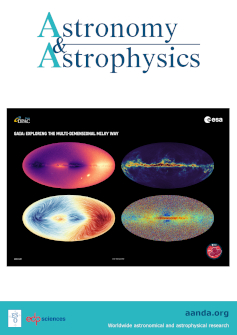Symbiotic stars in X-rays
IF 5.4
2区 物理与天体物理
Q1 ASTRONOMY & ASTROPHYSICS
引用次数: 0
Abstract
White dwarf symbiotic binaries are detected in X-rays with luminosities in the range of 1030–1034 ergs s−1. Their X-ray emission arises either from the accretion disk boundary layer, from a region where the winds from both components collide, or from nuclear burning on the surface of the white dwarf (WD). In our continuous effort to identify X-ray-emitting symbiotic stars, we studied four systems using observations from the Neil Gehrels Swift Observatory and XMM-Newton satellites in X-rays and from Transiting Exoplanet Survey Satellite (TESS) in the optical. The X-ray spectra were fit with absorbed optically thin thermal plasma models that are either single- or multitemperature with kT < 8 keV for all targets. Based on the characteristics of their X-ray spectra, we classified BD Cam as possible β-type, V1261 Ori and CD −27 8661 as δ-type, and confirmed NQ Gem as β/δ-type. The δ-type X-ray emission most likely arises from the boundary layer of the accretion disk, while in the case of BD Cam, its mostly soft emission originates from shocks, possibly between the red giant and WD and disk winds. In general, we find that the observed X-ray emission is powered by accretion at a low accretion rate of about 10−11 M⊙ yr−1. The low ratio of X-ray to optical luminosities, however indicates that the accretion-disk boundary layer is mostly optically thick and tends to emit in the far or extreme UV. The detection of flickering in optical data provides evidence of the existence of an accretion disk.X 射线中的共生恒星
白矮星共生双星在 X 射线中被探测到的光度范围为 1030-1034 尔格 s-1。它们的X射线发射要么来自吸积盘边界层,要么来自两个成分的风相撞的区域,要么来自白矮星(WD)表面的核燃烧。我们一直在努力寻找发射X射线的共生恒星,我们利用尼尔-盖尔斯-斯威夫特天文台(Neil Gehrels Swift Observatory)和XMM-牛顿(XMM-Newton)卫星的X射线观测数据,以及越轨系外行星巡天卫星(TESS)的光学观测数据,对四个系统进行了研究。对所有目标的 X 射线光谱都用吸收型光学薄热等离子体模型进行了拟合,这些模型要么是单温的,要么是多温的,kT < 8 keV。根据它们的 X 射线光谱特征,我们将 BD Cam 可能归为 β 型,V1261 Ori 和 CD -27 8661 归为 δ 型,并确认 NQ Gem 为 β/δ 型。δ型X射线辐射很可能来自于吸积盘的边界层,而BD Cam的大部分软辐射则来自于冲击,可能在红巨星和WD以及盘风之间。总的来说,我们发现观测到的 X 射线辐射是由低吸积率(约 10-11 M⊙ yr-1)的吸积所驱动的。然而,X射线光度与光学光度的低比值表明,吸积盘边界层大部分是光学厚层,倾向于在远紫外或极紫外辐射。在光学数据中探测到的闪烁现象为吸积盘的存在提供了证据。
本文章由计算机程序翻译,如有差异,请以英文原文为准。
求助全文
约1分钟内获得全文
求助全文
来源期刊

Astronomy & Astrophysics
地学天文-天文与天体物理
CiteScore
10.20
自引率
27.70%
发文量
2105
审稿时长
1-2 weeks
期刊介绍:
Astronomy & Astrophysics is an international Journal that publishes papers on all aspects of astronomy and astrophysics (theoretical, observational, and instrumental) independently of the techniques used to obtain the results.
文献相关原料
| 公司名称 | 产品信息 | 采购帮参考价格 |
|---|
 求助内容:
求助内容: 应助结果提醒方式:
应助结果提醒方式:


